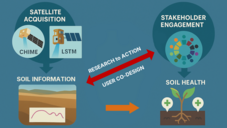Advancing Soil Health Monitoring through Sentinel Expansion Missions EO Data and Stakeholder-Driven Application Development | NextSoils+
The NextSoils+ project, funded under ESA’s Sentinel User Preparation (SUP) programme, addresses one of today’s most urgent environmental challenges: the monitoring and sustainable management of soil health. Soils are a non-renewable resource that underpin food security, biodiversity, and climate resilience. Yet, across Europe, they are increasingly degraded by unsustainable land use, climate change, and pollution, threatening their ability to provide essential ecosystem services such as carbon storage, water filtration, and crop production.
In response, NextSoils+ harnesses the unique potential of the forthcoming Sentinel Expansion Missions—CHIME (Copernicus Hyperspectral Imaging Mission for the Environment) and LSTM (Land Surface Temperature Monitoring)—in combination with complementary missions such as NASA’s SBG and CNES-ISRO’s TRISHNA. By exploiting synergies between hyperspectral VNIR–SWIR (400–2500 nm) and thermal infrared (8–12 μm) data, the project develops innovative methodologies to retrieve soil properties and indicators critical for sustainable agriculture and climate adaptation. These include soil organic carbon (SOC), texture, salinity, mineralogy, and soil moisture.
To prepare for the Sentinel missions, NextSoils+ performs advanced simulations of CHIME and LSTM data using high-quality airborne and satellite datasets, including EnMAP and PRISMA. These simulated datasets form the basis for developing and testing novel retrieval approaches that integrate machine learning, spectral libraries, and in situ reference data. Validation takes place across four representative case studies in Greece, Spain, Italy, and Israel, which encompass a wide variety of soil types, climatic conditions, and management challenges—from salinisation and erosion to drought risk and nutrient depletion.
A central pillar of the project is its stakeholder-driven approach. Farmers, agronomists, soil authorities, and agricultural companies are actively involved from the outset through workshops, surveys, and co-design sessions. This ensures that the tools developed respond directly to user needs, support compliance with policy frameworks such as the EU Soil Strategy for 2030, and can be seamlessly integrated into operational land management practices. Agronomists in particular are identified as key multipliers, bridging the gap between EO technologies and farmers.
Ultimately, NextSoils+ demonstrates how Sentinel Expansion missions can deliver actionable, cloud-ready applications that improve soil monitoring, guide sustainable land management, and strengthen resilience to climate change. By aligning scientific innovation with real-world requirements, the project contributes to the EU’s vision of healthy soils by 2050, paving the way for transformative impacts on agriculture, ecosystems, and society.
- InterBalkan Environment Center (I-BEC), Greece
- Research Centre for Energy, Environment and Technology (CIEMAT), Spain
- Institute of Methodologies for Environmental Analysis (IMAA) of the National Research Council of Italy (CNR), Italy
- University of Tuscia (UNITUS), Italy
- Tel Aviv University (TAU), Israel
- Milewski, R., Guillaso, S., Karyotis, K., Tsakiridis, N., Schmid, T., Pignatti, S., Casa, R., Ben-Dor, E., & Chabrillat, S. (2025). NextSoils+: Advancing Soil Health Monitoring through Sentinel Expansion Missions EO Data (CHIME & LSTM) and Stakeholder-Driven Application Development. ESA Living Planet Symposium 2025, Vienna.

